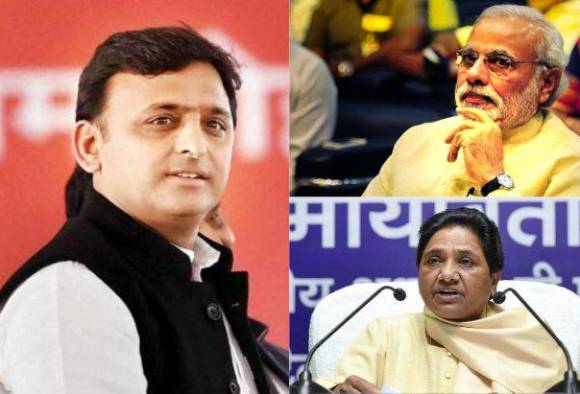By Amulya Ganguli (IANS)
Any satisfaction which the Bharatiya Janata Party (BJP) felt over the internal strife in the Samajwadi Party (SP) must have been diluted to a considerable extent by the truce, albeit an uneasy one, among the family members of its main political rival in UP.
Moreover, the emergence of a ‘mini-gathbandhan’ or an alliance between the SP and the Congress will be a reminder of the combine which squashed the BJP’s hopes in the Bihar assembly elections last year.
True, there’s many a slip between the cup and the lip. The disquiet in the Congress rank and file over a tie-up with the SP is an example, for one, of the bumpy road ahead for the putative partners and, for another, of the signs of life in the Congress — which is generally regarded as a moribund organisation.
Such an evidence of vitality is also bound to come to the fore if Priyanka Gandhi takes up campaigning for the Congress in real earnest.
The BJP, therefore, will be up against two major obstacles. One is a rejuvenated Akhilesh Yadav, fresh from his victory over his father, who wanted the chief minister to dump his pro-development agenda in favour of the SP’s customary politics based on caste and musclemen.
The other is the Congress, which has been politically astute enough to agree to play second fiddle in a state which once enabled the party to lord it over the rest of the country via leaders like Jawaharlal Nehru and Indira Gandhi.
The main advantage of the SP-Congress alliance is that it will attract the votes of large sections of the Muslims, who comprise 18 per cent of the state’s population, because of the belief that the “secular” combination can not only give the BJP a run for its money but perhaps even get the better of it.
As long as the SP was the victim of the father vs son squabbles, it was believed that the Muslims would tilt towards the Bahujan Samaj Party (BSP), whose leader, Mayawati, has promised not to build parks and memorials as during her last tenure as chief minister but concentrate on development.
Now, however, these calculations will have to be reworked. The BSP may retain its virtually impregnable Dalit vote bank, which constitutes 20.5 per cent of the population. But the Muslims are likely to drift away towards the SP, which already enjoys the support of the Yadavs, who make up nine per cent of the population, and other OBCs (Other Backward Classes) except the Kurmis who may stay with the Apna Dal, an ally of the BJP.
The X factor is to what extent Akhilesh will be able to jettison the SP’s baggage of being a party of goons and sell his development agenda a la Modi.
The BJP’s disadvantage in this battle of perceptions is that it doesn’t have a leader of stature in UP. There has been some talk, therefore, of the party projecting Rajnath Singh as the chief ministerial candidate. But the Union Home Minister is said to be unwilling to shift his base from Delhi to Lucknow in what can look like a demotion.
The task of winning UP, therefore, as also the states of Punjab, Uttarakhand, Goa and Manipur, will be wholly on Modi.
Although the prime minister single-handedly won the general election for his party in 2014 and also in the states of Maharashtra, Haryana, Jharkhand and Jammu and Kashmir in that year, he hasn’t been as successful since as the BJP’s defeats in the assembly elections of 2015 and 2016 (except in Assam) showed.
The failure of the economy to generate employment to the desired extent because of automation has also dampened his chances.
Besides, demonetisation has complicated Modi’s task. Although Nobel Laureate Amartya Sen — no admirer of Modi — has conceded that the Prime Minister remains popular, the jury is still out on whether the average people have forgiven Modi for their inconveniences.
As of now, most of the local elections have given the thumbs up to the BJP. But the real test will be in the assembly polls, especially in UP, where Modi will be pitted against a young leader who has understood the value of economic growth and is not hamstrung by the BJP’s communal tag or his own party’s caste-based approach to politics.
There is indeed a fear, therefore, that in case the BJP finds the going tough, it will fall back on the Hindutva card as the display of videos on the Muzaffarpur riots of 2013 by the BJP’s Sangeet Som, an accused in the riots case, shows.
There are also anti-minority politicians like Yogi Adityanath and Sakshi Maharaj in the background who can queer the pitch for the BJP.
If Modi succeeds in keeping such communal elements in his party and in the larger saffron brotherhood at bay, the country will see – perhaps for the first time – a contest where the economy, and not identity politics, will be the key factor.
If UP shows that caste and communalism can be dispensed with in an election campaign, it will become the paradigm of how politics should be conducted.


